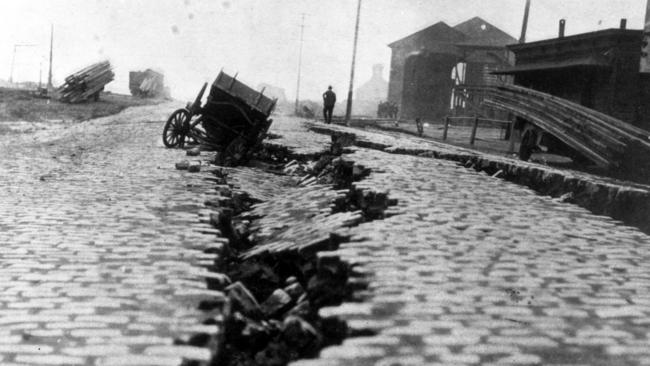Terror and death follow when the Earth moves
The devastation in Nepal attests to the enormous seismic pressures in some parts of the world

Today in History
Don't miss out on the headlines from Today in History. Followed categories will be added to My News.
The destructive forces unleashed in Nepal on the weekend attest to the incredible seismic forces that created the Himalayas and are what makes this part of the world so dangerous.
Although earthquakes go back to the dawn of time, it is the gathering of large numbers of people in places where the tectonic plates of the Earth’s crust meet that have made them so deadly in more recent times. The growth of towns and cities in areas of high seismic activity increases the likelihood of people dying when their built structures collapsed. Nepal’s last major earthquake, back in 1934, killed about 12,000 people.
The earliest recorded description of an earthquake was in China in 1177BC. It caused such destruction that the Chinese began to keep a comprehensive record of earthquakes. There was plenty for them to record over the centuries as they were hit by many more destructive quakes.
The worst on record in terms of death toll was the 1556 Shaanxi earthquake in which more than 800,000 people are thought to have died. A large number of deaths were due to the fact millions of people had made their homes by digging into the soft soil cliffs of the Loess Plateau. These cave dwellings collapsed during the earthquake, burying their inhabitants.
In 1920 a terrible earthquake estimated to have been a magnitude 8.0 hit Haiyuan province. The entire village of Sujiahe was wiped out by a landslide, with the final death toll estimated to have been more than 200,000.
A similar death toll followed the 1976 earthquake that flattened the city of Tangshan. Reaching a magnitude of 7.8, it struck in the early hours of the morning while most people were asleep, killing many of them in their beds.
The Japanese also live in a very seismically active area of the globe. Their worst tremor in terms of deaths was in 1923, when a quake rocked the Kanto region, including Tokyo. The 7.9 magnitude quake struck in the middle of the day when many people were cooking lunch, setting off fires all over Tokyo. Water mains were broken, preventing firemen effectively battling the flames. More than 140,000 people died.
More recently, the 1995 Kobe earthquake in Japan, although it was only a shallow earthquake measuring magnitude 6.8, killed 6434 people. One of the most famous images from the quake was the collapse of a 1km section of the elevated road and train line, the Hanshin Expressway.
About 90 per cent of the people who died were killed in their old wooden homes or apartments in a poorer section of Kobe. The 2011 magnitude 9.0 Tohoku earthquake and tsunami claimed the lives of more than 15,000 people and caused major damage to a nuclear power plant in Fukushima. The effects of that quake are still being felt in Japan today.
Europe also has a history of quakes. One of the worst of recent centuries was the Romanian earthquake of 1977 in which more than 1500 people died. Most were killed by the collapse of pre-WWII buildings. Italy has had many quakes in its history, including a 1693 tremor that killed more than 60,000 people. The death toll in the series of shocks in 2012 in Emilia-Romagna was about 27 people but it did billions of dollars of damage to buildings and destroyed precious cultural heritage.
One of the most infamous earthquakes of the 20th century was the 1906 San Francisco earthquake. Measuring a magnitude of about 7.9, its epicentre was off the coast of California. About 700 people were killed in the quake, with many more lives lost in the fires that resulted from ruptured gas mains. The final toll was about 3000. The tremors were felt as far south as LA, which has also had its share of ground shocks, including the 1994 earthquake that killed 57 people.
A quake in Alaska in 1964, which killed more than 100 people, was the second highest magnitude quake on record, measuring 9.2. The greatest magnitude quake ever recorded hit Chile in 1960, measuring 9.5. The number of dead is unknown but is estimated to have been about 1600.
HARDEST HITS
● Highest magnitude earthquake on record: Valdivia, Chile 1960 (pictured), magnitude 9.5
● Highest death toll from an earthquake: Shaanxi, China, 1556, more than 800,000 died
● Most likely city in the world to have fatalities during an earthquake: Kathmandu, Nepal
● Country where the most earthquakes occur each year: Japan
● Countries with the most number of devastating earthquakes: China and Iran



